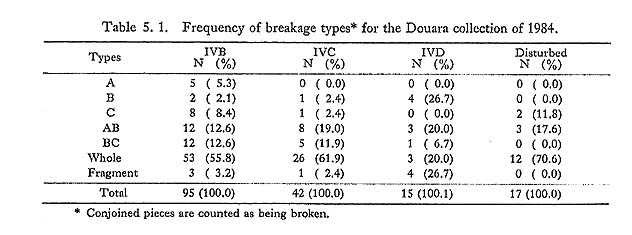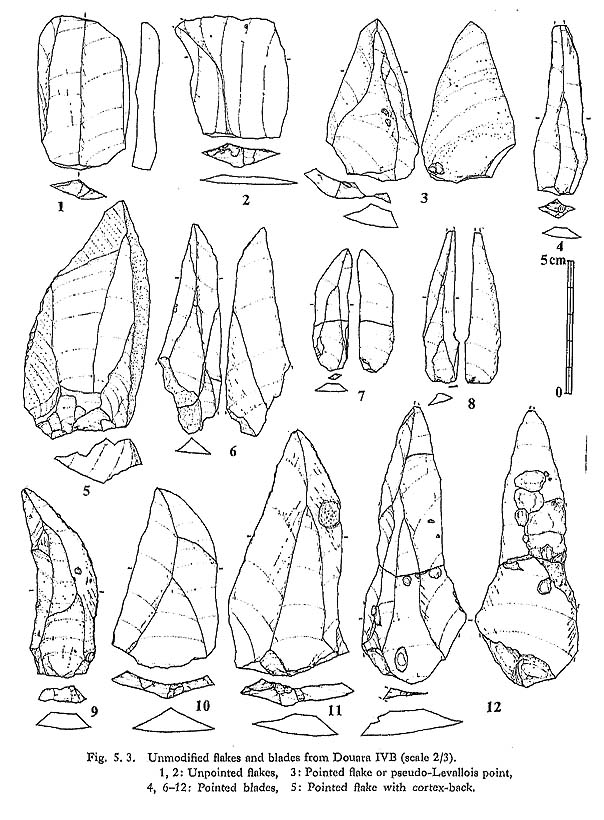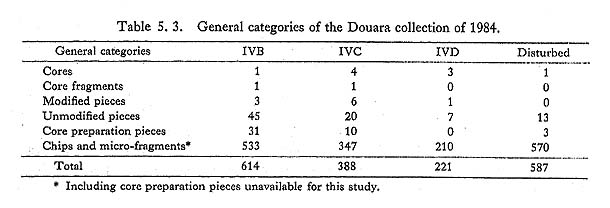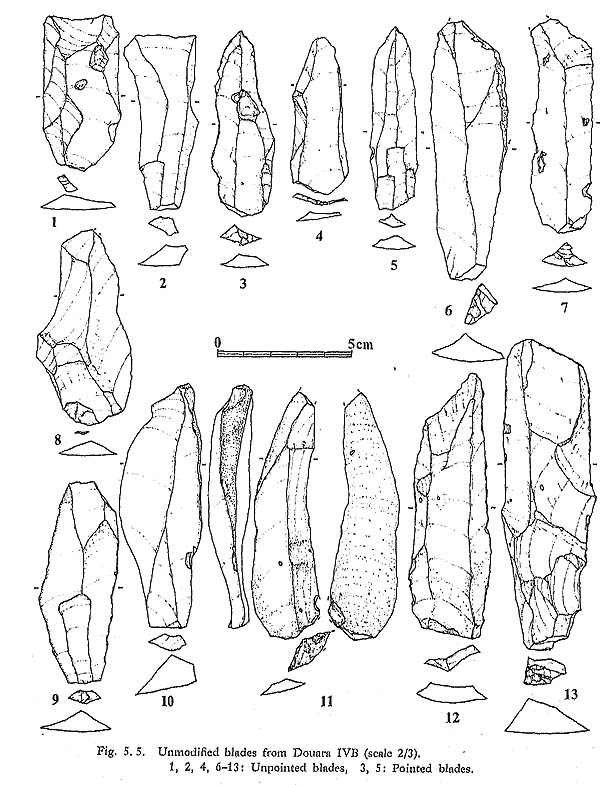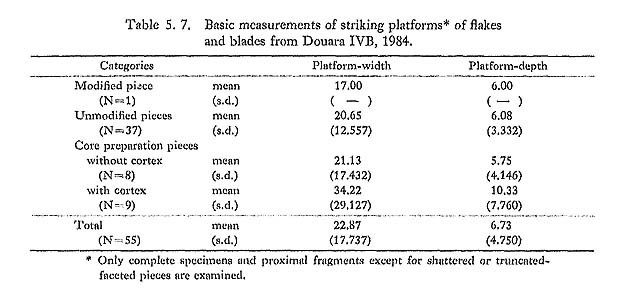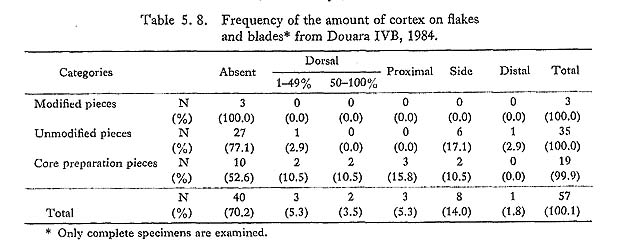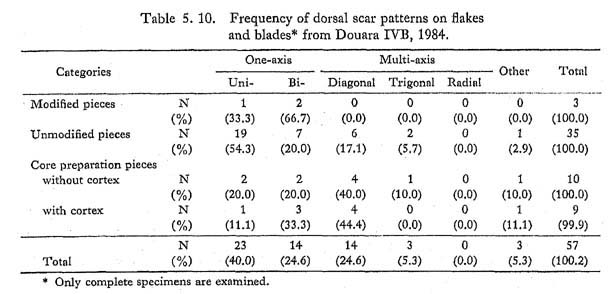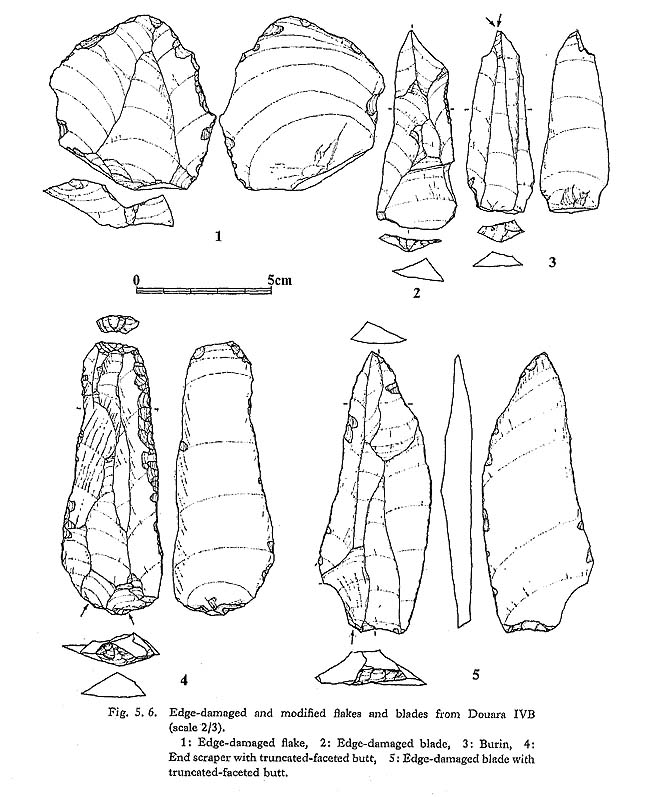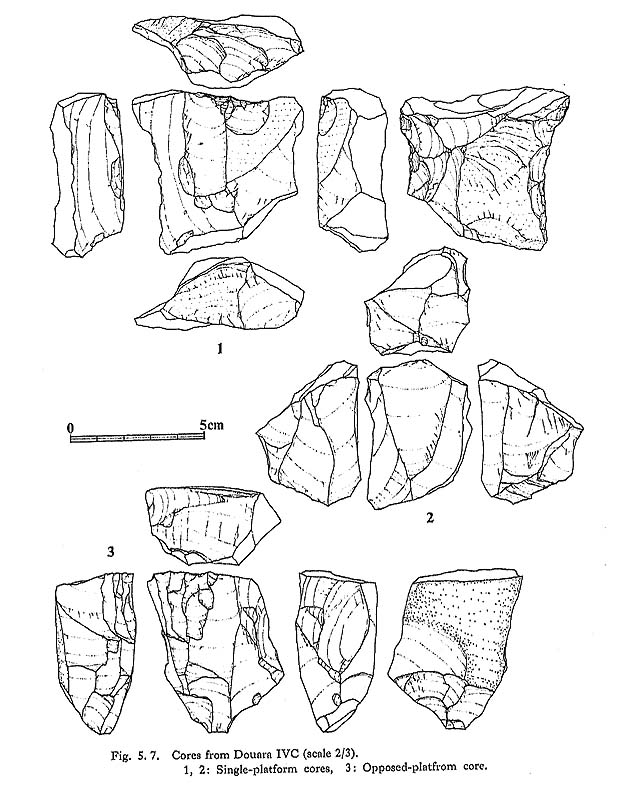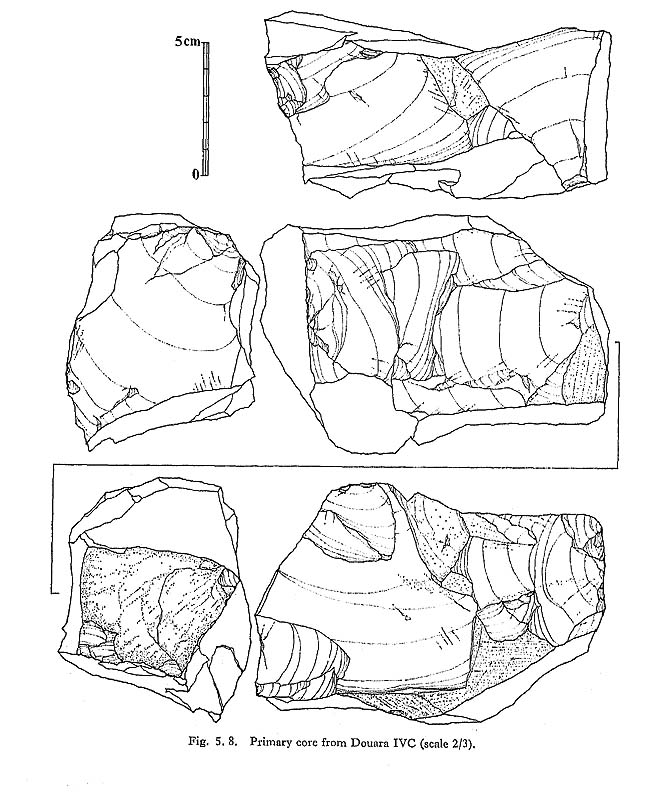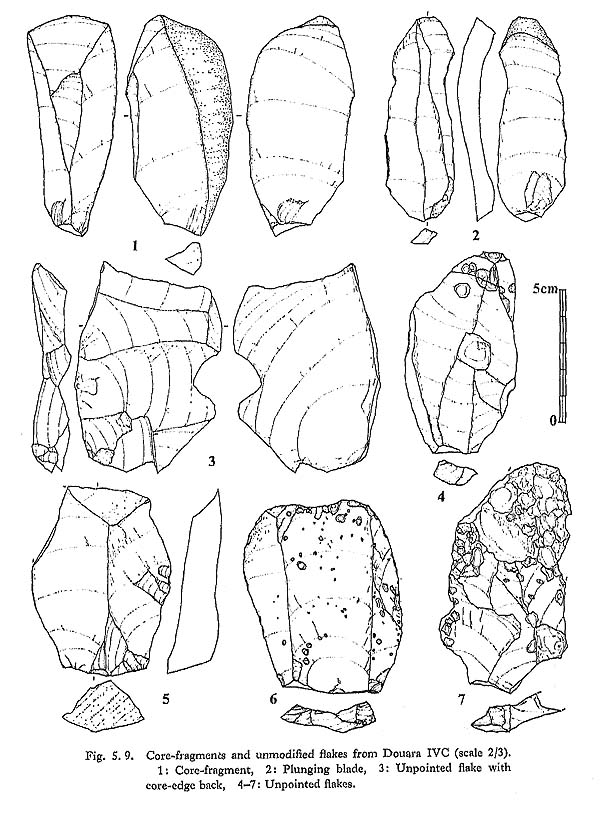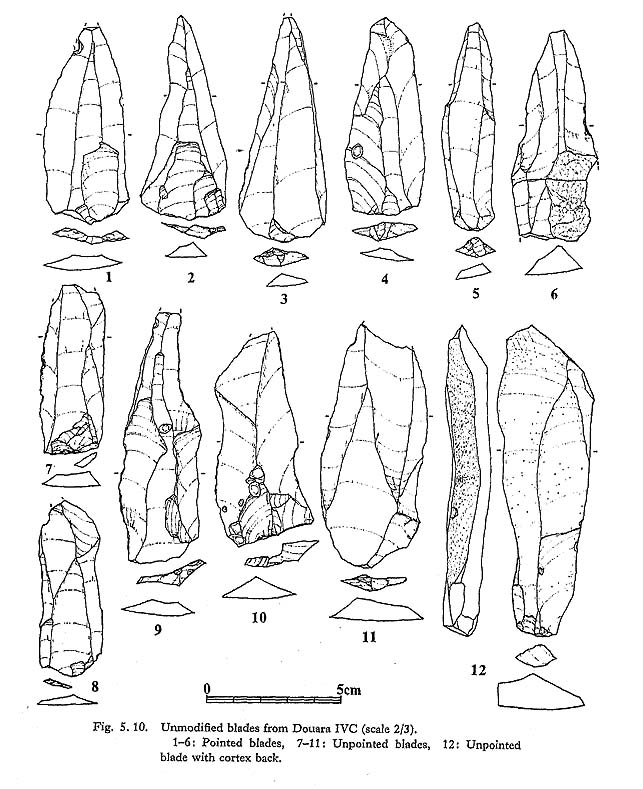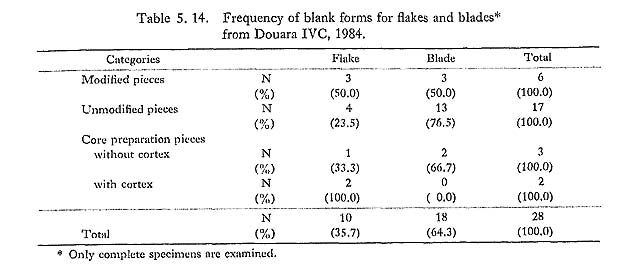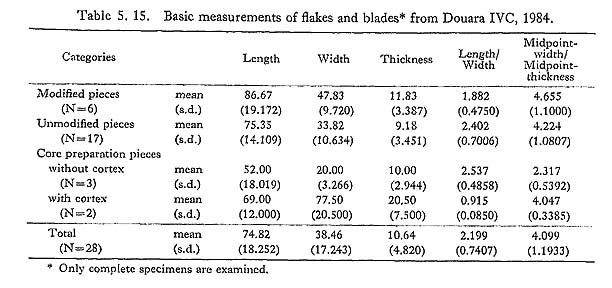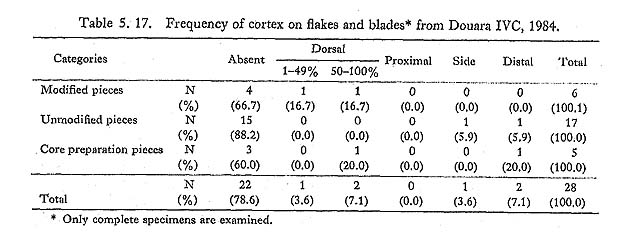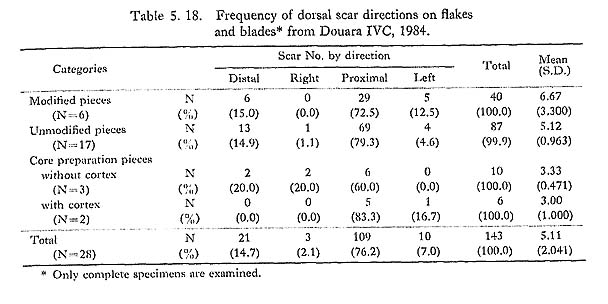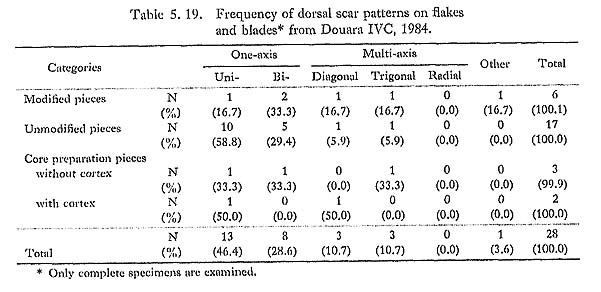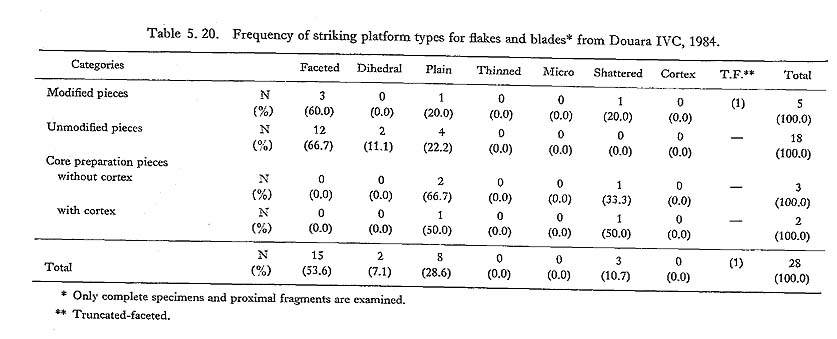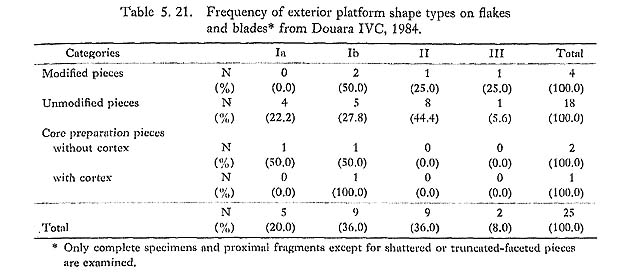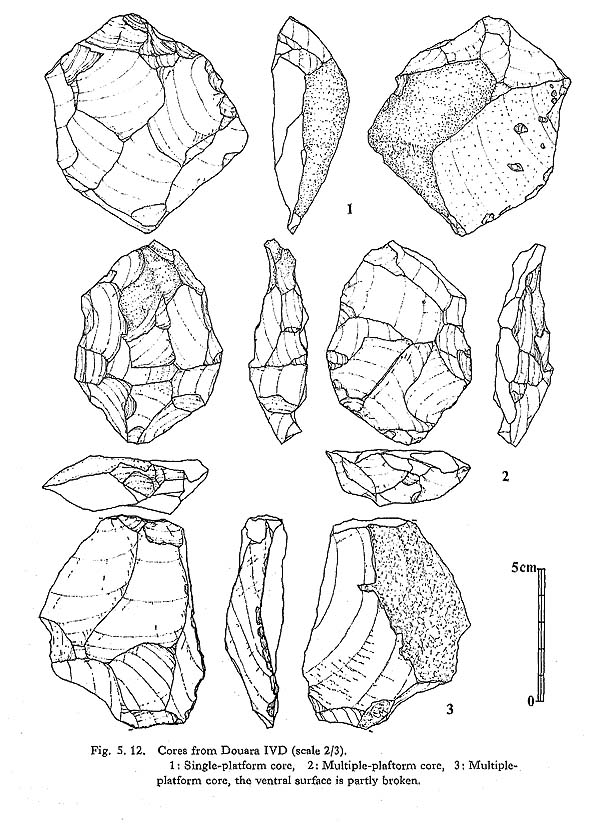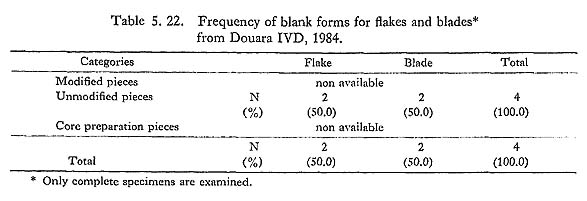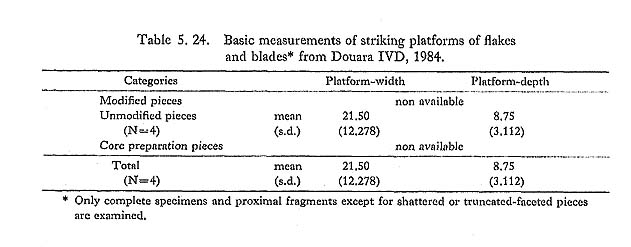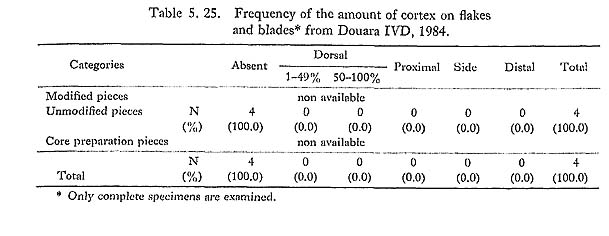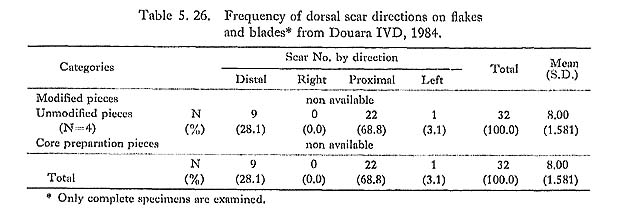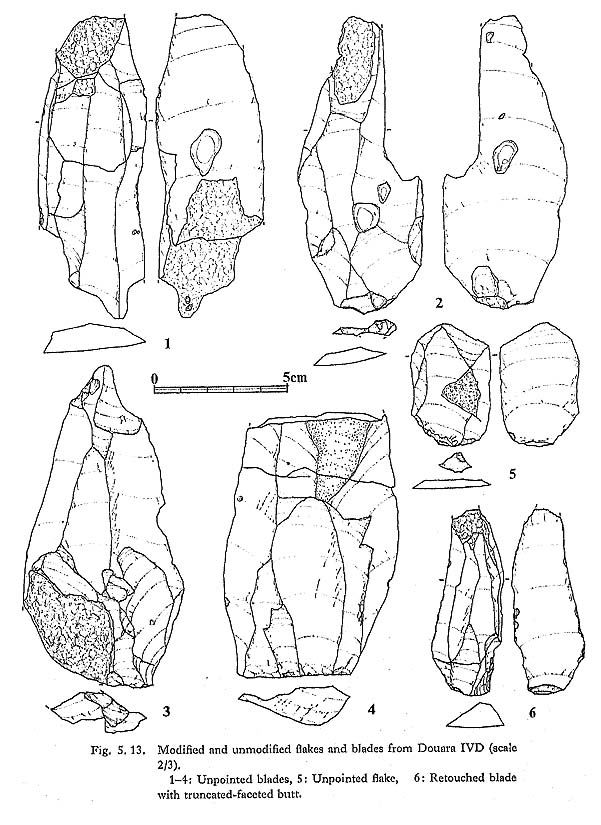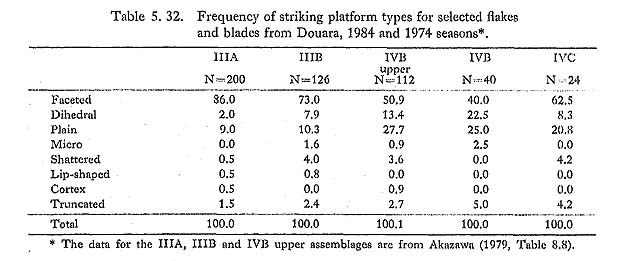CHAPTER 5
Middle Paleolithic Assemblages from the Douara Cave, 1984 Excavations
Yoshihiro Nishiaki
|
Douara Cave is on its way to becoming one of the most important Paleolithic sites in the Levant, since a long cultural sequence of the Middle Paleolithic including earlier phase of the Levantine Mousterian was exposed by the two seasons of 1970 and 1974 (Akazawa, 1974, 1976, 1979). The collection referred to in this chapter is the material obtained from stratified deposits of the cave in the third excavation at Douara, in 1984. The objective of this study is to present a detailed description of the 1984 collection. The description of the lithic assemblages emphasizes their technological characteristics in order to provide the basic data for comparison with other relevant assemblages in the Levant. The materials described here consist of three different stratigraphic groups: one from the lower level of IVB, and the others from the underlying IVC and IVD (for more details about stratigraphic sequence and excavation method, see Chapters 3 and 4 in this volume). 5. 1 PHYSICAL CONDITION OF FLINTSAll the lithic artifacts from the three stratigraphic units are made of flint. Their state of preservation is bad. A large number of the artifacts are broken (Table 5. 1, Fig. 5. 1) and highly brittle (e.g., Figs. 5. 3: 6, 12, 5. 4: 1, 2). Their color frequencies are shown in Table 5. 2. Black and gray are the common colors. Their physical conditions of pres ervation and color are possibly due to thermal actions, for the deposits from which the lithics are derived are all ash soils. In fact the lithics from disturbed portions of the cave, which involve non ash soils, do not suffer heavy breakage or color change to black or gray as shown in Tables 5. 1 and 5. 2.
The two tables show too that the physical conditions of the materials are different be tween the three units. The IVB and the IVD materials contain higher proportions of heavily broken specimens, such as types A, B, and C, than the IVC material (Table 5. 1). Dif ferences can also be seen in their color frequencies (Table 5. 2). Specimens that are gray to bluish-black in color are a large percentage of the IVB and the IVD materials, while they account for only a small part of the IVC material. These two differences in the con dition of the flints indicate that the flints of IVB and IVD have suffered greater thermal changes than those of IVC. The breakage pattern and the color of flints are comparable at Douara; broken flints have a higher frequency of specimens with gray to bluish-black color, while unbroken flints are more black or brown. The analysis of the condition of the flint suggests that the depositional contexts of the three stratigraphic units, IVB, IVC, and IVD were different, though all are constituted of ash soil. But this difference may be trivial in a geological sense as sedimentological analysis of the cave deposits does not suggest any significant depositional gap in Horizon IV (see Chapter 4 in this volume). 5. 2 DESCRIPTION OF LITHIC ASSEMBLAGESGeneral categories of lithic artifacts obtained during this season are shown by strati graphic unit in Table 5. 3. The materials examined are divided into two major groups: one is all the cores, core fragments, modified pieces, and unmodified pieces found during the excavations; the other is core preparation pieces selected randomly from the all complete specimens over 3 cm in maximum diameter, the reason for this selection being lack of time available to study all the collection during the stay in Syria. The specimens omitted here are the chips and micro-fragments obtained by ca, 2.5 mm mesh screening and several dozen small broken fragments or angular wastes to be classified as core preparation pieces. Their omission will not be a serious hindrance to a general understanding of the techno typological characteristics of the lithic assemblages.
5. 2. 1 IVB assemblageCoreOnly one core from the IVB was found (Fig. 5. 2: 1; Table 5. 4). This core is classified into multiple-platform type: it has three striking platforms around the periphery of the dorsal surface, and both of its surfaces are flaked. It is not a classic Levallois type core, though it has one broad flaking scar on the main surface. The main and the side surfaces have no centripetal preparatory scars, and the striking platforms are rather atypically formed. The striking platform for the largest scar is made by one large flaking scar which originates from the dorsal surface, and that for the opposite scar is made at an unusually acute angle to the main surface.
It is difficult to assess the total core technique of the IVB assemblage from only one core. This scanty sample is partly supplemented by the presence of plunging pieces: flakes and blades which retain the distal end of the cores from which they are detached. One plunging flake is classified as a core fragment (Fig. 5. 2; 2). Technological characteristics of the flake indicate that the core from which this specimen was detached has a dihedral or coarse ly faceted single platform, and does not have side or back preparation. The blank pro duction was executed uni-directionally along the axis of the core. This flake adds a singleplatform type of core into the inventory of cores of the IVB assemblage. The other plunging piece is a large blade (Fig. 5. 2: 3). The distal end of this blade retains the cortex and is heavily hinge-fractured. The dorsal scars do not run centripetally but unidirectionally. This specimen also indicates the use of a single-platform type of core in IVB. Flakes and bladesThe flakes and blades obtained during the 1984 season are described here following the classification scheme of Akazawa (1979: 2-12) with minor alterations. The flakes and blades are classified into three major categories: modified pieces, unmodified pieces and core preparation pieces. Modified pieces and unmodified pieces correspond to Akazawa's retouched blanks and unretouched blanks, and core preparation pieces correspond to his preparatory flakes (ibid., 11-12). Core preparation pieces are further divided into those with and those without cortex. Core preparation pieces with cortex correspond to the cortex flakes of Akazawa and those without cortex, to his secondary flakes and other smaller flakes. The most remarkable feature of the flakes and blades of the IVB assemblage is the dominance of blades in contrast to flakes (Table 5. 5, Figs. 5. 3 to 5. 5). Blades account for nearly 70% of the flakes and blades examined. Some of the blades have more or less pointed tips. But there are few definite triangular blades whose convergence to the tip clearly begins in the proximal part (Fig. 5. 3: 9-12).
The second important feature is the low frequency of Levallois flakes and points. The large number of blades should be classified into Levallois or non-Levallois in order to deter mine the proportion of Levallois blanks in the IVB assemblage. But this study reserves the classification since a serious problem is being raised about the definition of the Levallois blade in the study of the Early Levantine Mousterian including Douara (Copeland, 1981b, 1983a, 1985: 178). The Levallois Index of the IVB assemblage, without blades, is so low that it approaches 10. In fact the flake and point component of IVB is very poor in number and workmanship (Fig. 5. 3: 1-3, 5, 10). Various aspects of the morphological and technological features of blades and flakes are examined below in order to gain a general understanding of the flaking technique of IVB assemblage. Basic dimensions of the artifacts are measured in millimeters (Table 5. 6). The IVB flakes and blades are generally large for the Levantine Mousterian, specimens more than 10 cm in length make up a large proportion of the total (14.0%). The largest one is an unmodified plunging blade 126 mm. in length (Fig. 5. 1: 3).
General outlines are examined using the length-to-width ratio (Table 5. 6). The results show that the mean ratio is greater than 2.0. This reflects the preponderance of blade blank production in the IVB assemblage. Midpoint-width to midpoint-thickness ratios are calculated to determine the relative thickness of the material (Table 5. 6). This calculation follows the method developed by A. Jelinek at Tabun (Jelinek, 1977, 1981). The ratios for IVB concentrate around 4.0, which means the flakes and blades from IVB have rather thick cross sections. In comparing the dimensions and ratios for the three categories, modified pieces, unmodified pieces, and core preparation pieces, several trends emerge. One is that modified pieces are longer than the unmodified and the core preparation pieces. This is possibly a result of selection of longer blanks for modification by the Douara IVB people. Another trend is that modified and unmodified pieces differ morphologically from the core preparation pieces. The core preparation pieces are generally wider and thicker than the modified and unmodified pieces. A difference can also be seen between the cortical and the noncortical core preparation pieces. The cortical pieces are clearly wider and thicker in shape, which suggests that wider and thicker flakes and blades were produced in the early stage of the IVB technology's core reduction process. This strategy is reflected by the platform size of core preparation pieces (Table 5. 7). Cortical pieces have extraordinarily wider and thicker platforms compared to the others. The platforms of core preparation pieces without cortex are basically the same size as the modified and unmodified pieces.
Table 5. 8 shows the frequency of the amount of cortex on the artifacts. Cortical specimens account for nearly half of the core preparation pieces, while most of the unmodified and modified pieces show no cortex on their surfaces. This dichotomy clearly concerns the definition of core preparation pieces. Flakes and blades whose dorsal surfaces are at least half covered by cortex fit Marks' definition of primary elements (Marks, 1976: 376). Only two flakes correspond to his definition of primary elements in the IVB material.
The core and its relevant materials in the IVB assemblage indicate a lack of classic Levallois manufacturing technique. This is demonstrated by the analysis of dorsal scars on flakes and blades. The dorsal scars show strong uni-and bi-directional flaking. Nearly 90% of the scars originate either from proximal or distal ends of flakes and blades (Table 5. 9). This tendency corresponds to the predominance of the one-axis dorsal scar pattern in Table 5.10. These dorsal scars contrast with those on flakes and blades manufactured by classic Levallois techniques which have dorsal scars in a radial pattern.
It may be noted, however, that the core preparation pieces have relatively high proportions of multi-directional scar patterns (Table 5. 10). But this does not mean the collection contains deliberately prepared pieces like the classic Levallois pieces. The major type of multi-directional pattern present on core preparation pieces is a simple and irregular one; the diagonal type (Table 5. 10). In fact, the mean number of dorsal scars on these specimens is small, particularly on the cortical pieces. Striking platforms for flakes and blades are classified into several types (Table 5. 11). The most frequent type in the IVB material is the faceted one. The faceting is in general rather coarse. Very few specimens show finely faceted platforms (Fig. 5. 6: 2). Plain and dihedral types occupy fairly large proportions of the total. The use of the platform abrasion technique is negligible.
Perceived differences are born out by a comparison between the frequencies of striking platform types for unmodified pieces and for core preparation pieces. But, regrettably, there are too few modified pieces for comparison. Core preparation pieces show higher frequencies of dihedral and plain platforms than do unmodified pieces. This trend is quite apparent for the core preparation pieces with intact cortex. The technique of platform faceting seems not to have been used to peel cortex off cores. The exterior platform shapes of the IVB material were examined in order to elucidate the nature of point selection for the final blow (Table 5. 12). The classification scheme adopted here is summarized in Bergman and Ohnuma (1983: 172). Dominant are types I and II in the IVB assemblage. Flakes and blades with type I platform shape, where the point of the final blow is behind the dorsal central ridge, are about one-half the total. Type II platform shapes, whose final blow point is between the two dorsal ridges, are about 40% of the total. The study by Dibble (1981: 110) at Tabun suggests that type II flaking, platform dipping in his terms, was used to detach relatively thinner flakes. Table 5.12 shows this particular technique was not often used for decorticating cores in the IVB assemblage. This is also demonstrated by the low frequency of this type of specimen among the core preparation pieces with cortex. Indeed, the thickness of cortical pieces relative to non-cortical pieces was outstanding (Table 5. 6).
The flaking technique described above shows a strong tendency to produce blade blanks in the IVB assemblage. The ratio of blades to flakes is unusually high for the Levantine Mousterian period. These blades whether they are Levallois or not are detached by uniand bi-directional flaking and by using coarsely faceted striking platforms. Platform dipping is common. The technique of cresting for core preparation is not used in the IVB assemblage. Modified piecesOnly three types: end scraper, burin, and truncated-faceted piece exist in this collection. There are no common Mousterian tools such as side scrapers and retouched points (Table 5. 13). This scarcity of modified pieces is one of the major characteristics of the IVB assem blage. All the modified pieces are illustrated in Fig. 5. 6.
End scraper (Fig. 5. 6: 4) This specimen was made on a blade blank. The butt is partially truncated-faceted, i.e., the final blow point of the blank is in place, and two secondary flakes are detached from the dorsal surface. The scraping edge at the distal end is narrow and shows inverse retouch on part. The right lateral edge is retouched, as is the distal end. Burin (Fig. 5. 6: 3) A dihedral burin is made on a blade blank with a dihedral butt. The working edge is formed at the distal end by the intersection of two spall removals. Truncated-faceted piece (Fig. 5. 6: 5) This specimen is a pointed blade with a truncated-faceted butt. This may be called a flat type of burin, since the secondary flake scar on the dorsal surface is relatively deep. Both lateral edges clearly show edge damage, caused by utilization or by natural forces. 5. 2. 2 IVC assemblageCoresFour cores were found in stratigraphic unit IVC (Table 5. 4), and are illustrated in Figs. 5. 7 and 5. 8. One large primary core is included (Fig. 5. 8), which was discarded in the early stage of the core reduction process. The other cores are clearly exhausted. Single platform cores (Fig. 5. 7: 1, 2)
This group is composed of two. The first (Fig. 5. 7: 1) is rather atypical. The blank is a massive flake, the bulbar surface and striking platform of which have been used as the main flaking surface. The flaking scar on the main surface indicates that a small blade was detached from the single platform with facets. The opposite end of the platform also shows several flaking scars, but it is doubtful if this end was used as another platform since it is the last surface flaked in the manufacturing process. The dorsal surface has a large negative scar, both sides of which are concavely retouched. The second core (Fig. 5. 7: 2) has an amorphous shape because it has been heavily worked down. The platform is at the end of the core. All the flaking scars on the main, side and dorsal surfaces originate at the platform. No side preparatory scars perpendicular to the axis of the core can be seen. The main surface shows that this core yielded a pointed triangular flake. It is interesting to note that such flakes are quite rare in the IVC collection (Figs. 5. 9 to 5. 11).
The second type consists of a single opposed-platform core. The specimen has one plain platform, and one faceted platform at the opposite end. Typically, the general shape of this core is prismatic. Cortex remains on the dorsal surface. The large plain platform produced several small blades, most of which terminate at the end in a hinge fracture. The opposite platform also produced several small blades. Their scars produced a burin like edge. Primary core (Fig. 5. 8) The third type is a primary core. When compared with the other cores it is unusually large. This core's early abandonment is probably due to its coarse flint quality. There are many inclusions and joint-surfaces on the surfaces of the core, which are rare on the smaller cores. Cores like this one show the early stages of core preparation which are not present on most cores. This particular core is an opposed-platform type with a rectangular solid shape. There are platforms at both ends: one has a plain surface and the other has a flaked joint-surface. Both of the platforms produced broad flakes, most of which terminated in a hinge- or step-fracture. Several flakes and blades which retain the morphological characteristics of the cores from which they were detached are described here. The first is the large core fragment shown in Fig. 5. 9: 1. This specimen has one platform and uni-directional flaking scars on its main surface. The dorsal surface is covered with cortex. This specimen is possibly a fragment of a single-platform type core designated as a summary Levallois core by Cope-land (1983: 272). The next figure ia of a plunging blade with uni-directional scars on its dorsal surface (Fig. 5. 9: 2). This blade could also have been produced from a single platform type core with minimal preparation. The specimen in Fig. 5. 9: 3 is a core-edge flake. It has a faceted platform, and retains multi-directional flaking scars on its dorsal surface. This flake may have rejuvenated the main surface of a multiple-platform core. Thus, the cores of the IVC assemblage are mostly single- and opposed-platform types. The main and side surfaces of these one-axis cores do not have the characteristic preparation of the classic Levallois, and their striking platforms are simply made in general. Though typical prismatic cores are found, evidence of use of the cresting technique for core preparation cannot be seen in the assemblage examined. Flakes and bladesIn the IVC assemblage, as in the IVB assemblage, blades are the dominant type of blanks (Table 5. 14). The flaking technique seen in the IVC assemblage seems geared toward blade blank production. There are few classic Levallois flakes and points in the IVC assemblage (Figs. 5. 9, 5. 10). The Levallois Index without blades is below 20.
Basic measurements of the artifacts are listed in Table 5. 15. The flakes and blades of the IVC assemblage are generally large. The largest specimen is a modified primary blade that measures 119 mm in length (Fig. 5. 11: 4). The ratios of length to width and midpoint-width tomidpoint-thickness demonstrate that the IVC material is narrow and thick. There are two kinds of blank selection for modified pieces in the IVC assemblage (Table 5. 15). One selection calls for large blades, and the other favors flake blanks instead of blades (Table 5. 14). The latter selection is reflected in the differences in the two ratios of length to width and midpoint-width to midpoint-thickness between the modified pieces and the unmodified and core preparation pieces.
Core preparation pieces are normally thicker and smaller than modified and unmodified pieces. The core preparation pieces with cortexes are quite large in contrast to those without cortexes. These differences are also examined in terms of platform size in Table 5. 16.
Dorsal scar directions and patterns on the IVC flakes and blades have been examined. Dorsal scars which originate from proximal or distal ends account for around 90% for the total scars found (Table 5. 18). Three-fourths of the total specimens have a one-axis scar pattern on their dorsal surfaces (Table 5. 19). These figures indicate a strong uni- and bi-directionalism in the core reduction strategy in the IVC assemblage. It should be noted, however, that some flakes and blades have complicated scar patterns such as the modified flake illustrated in Fig. 5. 11: 3. This flake has a trigonal scar pattern, Uni- and bi-directional flaking is the dominant form of flaking in the IVC assemblage; multiple flaking was executed, but only rarely.
The number of dorsal scars fluctuates widely among the three categories (Table 5. 18). Core preparation pieces have only a few acars on their dorsal surfaces, while the other pieces have a moderate number of scars. Platform faceting is common in the IVC assemblage (Table 5. 20). More than one half of all the platforms in the collection arc faceted striking platforms. This faceting is, however, rather coarse except for a few fine specimens (Fig. 5. 11:5, 6). This technique is not often applied for core preparation pieces, especially cortical preparation pieces.
Exterior platform shapes show the location of a final blow point for the production of flakes and blades (Table 5. 21). The type I blows outnumber the II and III types. There is a marked difference between the frequency of blow types for the modified and unmodi fied pieces and the core preparation pieces. While a fairly large number of the modified and unmodified specimens are detached by the type II of blow, core preparation pieces are only detached by the type I blow.
Modified piecesSix modified pieces were found in the IVC assemblage. They consist of one side scraper, two notched pieces, one truncated-faceted piece and two pieces retouched on the base (Table 5. 13; Fig. 5. 11). The pieces are only slightly modified, and quite similar in outline to their blanks. The first is a side scraper on a blade with a shattered butt. The tip was slightly broken. Both lateral edges are working edges; one convex and the other concave. The retouch scars are irregular and shallow. Notched pieces (Fig. 5. 11: 2, 3) Two notched pieces were found. The one is made out of a thick Levallois flake with a faceted butt and a complicated dorsal scar pattern (Fig. 5. 11:3). There are two notches on the left lateral edge. Both of them are made by deliberate retouch flakings. Though the two notches form a kind of projection with a broken tip, this specimen can hardly be called a drill, for the projection is quite dull. The second is an irregular triangular flake with a coarsely faceted butt (Fig. 5. 11: 2). One notch was made on the ventral surface using one or two blows. The right edge, in addition to the notched part, has edge damage. Truncated-faceted piece (Fig. 5. 11: 5) This is a blade with a half truncated-faceted butt. The angle formed by the two secondary flake scars on the dorsal surface and the truncated-faceted surface is acute. Clear edge damage is only boserved along the left edge. Retouched pieces (Fig. 5. 11: 4, 6) Two pieces are classified as retouched pieces since they are not definite tool types. The blank used in the first specimen is a large primary blade (Fig. 5. 11: 4). Much of the dorsal surface is covered with cortex, and retouch blows can be seen near the cortexed part of the base. The retouch scars are fairly steep, and some of them are stepped. The second piece is a flake with the base slightly modified by tiny inverse retouching (Fig. 5. 11: 6). The butt shows clean faceting. The dorsal scar pattern suggests this flake is produced by a 'Nubian' type of flaking process. The pot lid breakage on the dorsal and ventral surfaces is the result of heating. 5. 2. 3 IVD assemblageCoresThere are three cores from this assemblage. One is a single-platform type and the others are multiple-platform cores (Table 5. 4). Single-platform core (Fig. 5. 12: 1)
This core has one faceted striking platform. The absence of side and back preparation is characteristic of Copeland's summary Levallois core. The flaking scars show that broad flakes were detached from this core in the last stage. Except for the platform and cortex, the dorsal surface is covered with one large flaking scar with an old. patina. Multiple-platform cores (Fig. 5. 12: 2, 3) The first core has an elongated discoidal form (Fig. 5. 12: 2) with multi-directional flakings on the main surface, as well as neatly flaked peripheral platforms. The flaking scars on the main surface are not laminar but are broad. The second core is thin like the other cores from the IVD assemblage (Fig. 5. 12: 3). Both surfaces retain broad flaking scars. The right half of the dorsal surface was broken by heating. Though this core seems to have only a single platform, the scar pattern on the main surface shows that there was originally another platform on the broken side of the core. The right lateral edge has steep regular retouch scars or edge damage. Flakes and bladesOnly a small part of the IVD deposit was exposed during the 1984 season; consequently there are only four flakes and blades available for study. The same descriptive system used for the IVB and the IVC assemblages is used for the IVD assemblage. The results are presented in Tables 5. 22 to 5. 29, and Fig. 5. 13. These seem to suggest the IVD flaking techniques have the same characteristics as IVB and IVC, i.e., a strong tendency toward blade production, coarsely faceted striking platforms, and one-axis flaking scars on the dorsal surfaces of flakes and blades. However, it is impossible to make any final state ment on the IVD technology with such a small sample.
Modified piecesOnly one specimen was found (Table 5. 13). Retouched piece (Fig. 5. 13: 6) This specimen suffered heavy breakage and was made brittle by thermal actions. The right lateral edge of the base is modified by steep retouch blows from the ventral surface of the blank. The butt is snapped or broken, and one secondary flake is detached from the dorsal surface. This specimen can be called a 'summary truncated-faceted piece'. 5. 3 SUMMARY AND CONCLUSIONSThe preceding sections have described the Middle Paleolithic assemblages from the three stratigraphic units of Douara Cave excavated in 1984. Although only two stratigraphic units, IVB and IVC yielded an insufficient sample size of lithic assemblages, the general relationships between the IVB and the IVC assemblages in technological and typological features may be summarized. Technologically, there are many similarities between the IVB and the IVC assemblages: (1) The dominant type of core in both assemblages is the single-and opposed-platform core without deliberate preparation. Levallois type cores in the strict sense (cores with a single faceted platform and deliberate preparation on the main and side surfaces) are absent. The cores and their relevant artifacts resemble Copeland's summary Levallois. (2) The dominant blank form is a blade in both assemblages. Blades represent nearly 70% of all the flakes and blades examined in the assemblages. Many of these blades, whether Levallois or not, have relatively thick cross sections. There are very few classic Levallois flakes and points in both assemblages. (3) Most of the flakes and blades are produced from cores by uni-or bi-directional flaking. Flakes and blades which retain multi-directional scars on their dorsal surfaces are rare. This is compatible with the absence of classic Levallois cores noted above. (4) The platforms for the flakes and blades of both assemblages are mainly prepared by coarse faceting or remain plain. The platform dipping technique is used moderately in both assemblages. Typologically, there are also basic sinailarities between the IVB and IVC assemblages. (1) In both assemblages modified pieces are very few. The remarkable point is the rarity of common Mousterian tools such as retouched points and various side scrapers. The only tool type common to both assemblages is a truncated-faceted piece. (2) The modifications on flakes and blades are very minor and do not alter the original blank forms. Even truncated-faceted pieces are simply made. Though the IVB and IVC assemblages have these strong technological and typological similarities, it is to be noted there are several differences between them. For example, technologically, the frequency of faceted platforms (Tables 5. 11, 5. 20) is slightly higher in the IVC than in the IVB assemblage. Typologically, the proportion of the modified pieces in the IVC assemblage is higher than that of the IVB assemblage (Table 5. 3), and the tool inventories of the assemblages are unequal (Table 5. 13). However, evaluation of the significance of these differences is difficult with such small samples. In fact, the differences may be a simple reflection of the sample size or our sample selection. Although final conclusions well have to await further excavations, there is little doubt that the IVB and IVC assemblages are basically similar in both technological and typological features. The next task is to examine the relationships of the above assemblages to those of the overlying stratigraphic units exposed during the previous season. The excavations at Douara in 1974 yielded three Middle Paleolithic assemblages from the stratigraphic units IIIA and IIIB and the upper level of unit IVB. These assemblages are similar in general aspects, but Akazawa's detailed analysis (Akazawa, 1979; also Copeland, 1981a: 256) has demonstrated that the IVB upper assemblage (the assemblage of the upper level of the stratigraphic unit IVB excavated in 1974 is denoted here as 'IVB upper' in order to avoid confusion with the IVB assemblage obtained during the 1984 season) differs significantly from the overlying IIIA and IIIB assemblages in technological aspects. According to Akazawa's analysis, the technological differences are summarized as follows: 1) prismatic non-prepared cores are peculiar to the IVB upper, while classic Levallois type cores are dominant in the IIIA and IIIB; 2) the proportion of blades is very high in the IVB upper, while the proportions in the IIIA and the IIIB are moderate; 3) uni-or bi-directional flaking outnumbers multi-directional flaking in the IVB upper while multi-directional flaking is predominant in the IIIA and the IIIB; 4) most of the platforms for flakes and blades are coarsely faceted or not faceted in the IVB upper, while most of the platforms are deliberately faceted in the IIIA and the IIIB. Examining the technological aspects of the IVB and IVC assemblages of 1984 in this context, it is evident that the IVB and IVC have undoubted affinities with the IVB upper assemblage. The results of comparisons in blank form, flaking direction and platform preparation are summarized in Tables 5. 30-32. Although there are several slight fluctuations of the figures in these tables, especially in the tables for width/length ratio (Table 5.30) and for platform preparation (Table 5. 32), no substantial differences can be seen between the IVB and IVC assemblages and the IVB upper assemblage. They present one form of a peculiar industry in contrast to the Levantine Mousterian of the overlying units.
As for the typological relationships, Akazawa (1979: 22-23) pointed out differences between the IVB upper and the IIIA and IIIB assemblages: typical burins and side scrapers on cortex blanks are particular to the IVB upper assemblage. Though a typical burin of the IVB (Fig. 5. 6: 3) and a retouched piece on a cortex blank of the IVC (Fig. 5. 11: 4) are similar to artifacts in the IVB upper assemblage, the data for the IVB and IVC assemblages are too few for an adequate comparison. The similarities among the Horizon IV assemblages that I wish to stress here are the low frequency of retouched tools and the rarity of common Mousterian tools. In conclusion, the 1984 excavations at Douara provided additional data to support the potential technological change in the Middle Paleolithic sequence at the cave. The excavations confirmed the appearance of a distinct blade-geared industry before the Levantine Mousterian with the classic Levallois technique flourished at the cave. Although the problem of whether the blades of this industry should be called Levallois remains unsolved, the industry is surely associated with blank production techniques which are different from the 'classic' Levallois technique. When combined, the assemblages of this season and the previous one reveal a long Middle Paleolithic sequence at the cave and supply a rare opportunity to study chronological change in the Levantine Mousterian. It must be emphasized, finally, that further excavations and studies are needed to establish the exact sequence at Douara. The assemblages exposed by the 1984 excavations are defined from very few flint artifacts. Typological data are especially lacking. It is hoped that further excavations at the cave will clarify the prehistoric context of the assemblages so far unearthed and will provide new data on the underlying stratigraphic units as yet unexposed. LITERATURE CITED
|
